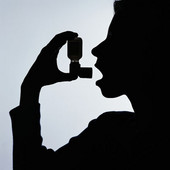
TUESDAY, May 3 (HealthDay News) — The number of Americans suffering from asthma continues to rise, jumping more than 12 percent between 2001 and 2009, U.S. health officials said Tuesday.
That’s an increase of 4.3 million people, according to the U.S. Centers for Disease Control and Prevention (CDC), which released the report.
About 25 million Americans have asthma “and that number, unfortunately, is rising,” the CDC’s Principal Deputy Director Ileana Arias said during a noon press conference. “We don’t know exactly why the rate is going up, but there are measures that individuals with asthma can take to control asthma symptoms.”
All those new asthmatics are pushing the price tag for asthma care in the United States upwards, too — from about $53 billion in 2002 to roughly $56 billion five years later, about a 6 percent rise.
“Asthma is a chronic disease, but it can be controlled by taking medicine and avoiding the triggers that can cause an attack,” Arias noted. Even so, about 50 percent of those with asthma still have severe attacks each year, Arias said. In addition, 3,447 Americans died from asthma in 2007, she said.
This upsurge in asthma was seen across all ethnic and racial groups, the CDC said, with more cases among children (9.6 percent) than adults (7.7 percent) in 2009. The rate was particularly high among boys, with 11.3 percent having the illness.
Asthma hit black children especially hard, with an almost 50 percent increase in cases from 2001 to 2009. In fact, by 2009 a full 17 percent of black children suffered from asthma, the greatest for any racial/ethnic group, the report finds.
One asthma expert, Dr. Shirin Shafazand, assistant professor of medicine at the University of Miami Miller School of Medicine, said the finding wasn’t a surprise. “We see the same trends — those who are poor, children and blacks are more at risk,” she said.
These are the people we should be targeting with education and asthma management, Shafazand said. “But because of lack of insurance, many don’t have access to medication and physicians. The message is to try to reduce this disparity.”
Indeed, the per-person cost for treating asthma averaged about $3,300 per year from 2002 to 2007, but many people went without proper care. Insurance coverage mattered greatly in that respect: 2 in every 5 uninsured people with asthma were unable to afford medication to treat their condition, compared to 1 in every 9 people with insurance, the CDC said.
Right now, CDC officials say they aren’t sure why asthma rates continue to surge. But in the meantime, the agency recommends these measures to stem the tide:
- Improving indoor air quality for asthmatics through smoke-free air laws.
- Teaching asthmatics how to avoid triggers such as tobacco smoke, mold, pet dander and air pollution.
- Encouraging doctors to prescribe inhaled corticosteroid drugs for all chronic asthma patients and teaching patients how to manage their symptoms with an action plan.
- Promoting ways of preventing asthma attacks, such as access to corticosteroids and other asthma drugs.
- Encouraging doctors and others to conduct environmental assessments and asthma education sessions.
Asthma causes wheezing, breathlessness, chest tightness, and coughing. People with the condition can control their symptoms and prevent attacks by avoiding triggers and using medications, such as inhaled corticosteroids.
Dr. Norman H. Edelman, chief medical officer of the American Lung Association, called the new CDC data “an important report as it shows we are still far from having achieved control of the asthma epidemic in this country.”
It is difficult to speculate on the cause of the continuing increase in asthma, said Edelman, who is also a professor of preventive medicine, internal medicine, physiology & biophysics at Stony Brook University in N.Y. “We now know, for example, that obesity makes asthma worse and may bring out asthma in those who have the tendency. Thus some have speculated that the rise in prevalence might be related to the obesity epidemic.”
Despite the bad news on prevalence, there is some good news on asthma control, although not in this report, Edelman said.
“Over about the same period of time, deaths from asthma have dropped by about a third, and emergency room visits for asthma have declined,” he noted. “Most think that this is related to more use of inhaled steroids. Sadly, the report indicates that still too few asthma patients are using inhaled steroids.”
Shafazand believes dirtier air and allergens such as dust, pet dander and secondhand smoke may be driving the increase in asthma. But, she added that the best way to treat asthma is to control it.
“If you have asthma, you need to take responsibility to talk to your physician and learn what to do and [ask] ‘how can I change my lifestyle to improve things?,'” Shafazand said. “In the case of children, the parents need to take that responsibility,” she said.
More information
For more information on asthma, visit the U.S. National Library of Medicine.

